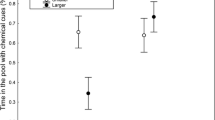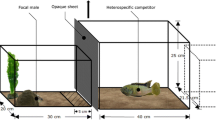Abstract
Recognition and avoidance of conspecifics based on chemical cues could reduce the risk of aggressive interactions between males. Success in agonistics encounters with unfamiliar males should be lower than with previously known familiar males. Then, males should avoid the chemicals from unfamiliar males with respect to those from familiar males. However, boldness and size could affect the outcome of encounters between males and, consequently, the response to chemical cues of conspecific males. We compared the time spent by male turtles Mauremys leprosa in water pools with chemical stimuli from unfamiliar or familiar males or with their own chemical stimuli. We also performed a behavioral test to estimate boldness of turtles in an antipredatory situation. Turtles avoided the chemicals from unfamiliar males respect to familiar ones and their own odors, but their responses depended on boldness and size of the tested turtle. Bold turtles avoided water with chemicals of unfamiliar males, but not with chemicals of familiar males, whereas shy turtles avoided chemicals of both familiar and unfamiliar males. On the other hand, large males avoided the odor from unfamiliar males, but small males did not avoid water with the odor from other males. Results suggest that male M. leprosa can detect chemicals released to water from conspecific males and discriminate between familiar and unfamiliar males. However, responses to these chemicals depended on boldness and body size of the responding turtle because these factors may affect intrasexual competition.

Similar content being viewed by others
References
Alberts AC, Rostal DC, Lance VA (1994) Studies on the chemistry and social significance of chin gland secretions in the desert tortoise, Gopherus agassizii. Herpetol Monogr 8:116–124
Aragón P, López P, Martín J (2000) Size-dependent chemosensory responses to familiar and unfamiliar conspecific faecal pellets by the Iberian rock-lizard, Lacerta monticola. Ethology 106:1115–1128
Aragón P, López P, Martín J (2001) Chemosensory discrimination of familiar and unfamiliar conspecifics by lizards: implications of field spatial relationships between males. Behav Ecol Sociobiol 50:128–133
Aragón P, López P, Martín J (2003) Differential avoidance responses to chemical cues from familiar and unfamiliar conspecifics by male Iberian rock lizards (Lacerta monticola). J Herpetol 37:583–585
Aragon P, Lopez P, Martin J (2007) Familiarity modulates social tolerance between male lizards, Lacerta monticola, with size asymmetry. Ethol Ecol Evol 19:69–76
Bury RB, Wolfheim JH (1973) Aggression in free-living pond turtles (Clemmys marmorata). Bioscience 23:659–662
Bury RB, Wolfheim JH, Luckenbach RA (1979) Agonistic behavior in free-living painted turtles (Chrysemys picta bellii). Biol Behav 4:227–239
Busack SD, Ernst CH (1980) Variation in Mediterranean populations of Mauremys Gray 1869 (Reptilia, Testudines, Emydidae). Ann Carnegie Mus 49:251–264
Cadi A, Joly P (2003) Competition for basking places between the endangered European pond turtle (Emys orbicularis galloitalica) and the introduced red-eared slider (Trachemys scripta elegans). Can J Zool 81:1392–1398
Carazo P, Font E, Desfilis E (2007) Chemosensory assessment of rival competitive ability and scent-mark function in a lizard, Podarcis hispanica. Anim Behav 74:895–902
Carazo P, Font E, Desfilis E (2008) Beyond ‘nasty neighbours’ and ‘dear enemies’? Individual recognition by scent marks in a lizard (Podarcis hispanica). Anim Behav 76:1953–1963
Colleter M, Brown C (2011) Personality traits predict hierarchy rank in male rainbow fish social groups. Anim Behav 81:1231–1237
Cooper WE Jr, Frederick WG (2007) Optimal time to emerge from refuge. Biol J Linn Soc 91:375–382
Da Silva E (2002) Mauremys leprosa (Schweiger, 1812). Galápago leproso. In: Pleguezuelos JM, Márquez R, Lizana M (eds) Atlas y libro rojo de los anfibios y reptiles de España. Asociación Herpetológica Española-Ministerio de Medio Ambiente, Madrid, pp 143–146
David M, Cezilly F (2011) Personality may confound common measures of mate-choice. PLoS One 6:e24778
DeRosa CT, Taylor DH (1980) Homeward orientation mechanisms in three species of turtles (Trionyx spinifer, Chrysemys picta, and Terrapene carolina). Behav Ecol Sociobiol 7:15–23
Dingemanse NJ, Wright J, Kazem AJN, Thomas DK, Hickling R, Dawnay N (2007) Behavioural syndromes differ predictably between 12 populations of three-spined stickleback. J Anim Ecol 76:1128–1138
Elnitsky MA, Claussen DL (2006) The effects of temperature and inter-individual variation on the locomotor performance of juvenile turtles. J Comp Physiol B 176:497–504
Fisher J (1954) Evolution and bird sociality. In: Huxley JS, Hardy AC, Ford EB (eds) Evolution as a process. Allen and Unwin, London, pp 71–83
Froese AD, Burghardt GM (1974) Food competition in captive juvenile snapping turtles, Chelydra serpentina. Anim Behav 22:735–740
Fuxjager MJ, Montgomery JL, Becker EA, Marler CA (2010) Deciding to win: interactive effects of residency, resources and ‘boldness’ on contest outcome in white-footed mice. Anim Behav 80:921–927
Galeotti P, Sacchi R, Pellitteri-Rosa D, Fasola M (2007) Olfactory discrimination of species, sex, and sexual maturity by the Hermann’s tortoise Testudo hermanni. Copeia 2007:980–985
Glinski TH, Krekorian CO (1985) Individual recognition in free-living adult male desert iguanas, Dipsosaurus dorsalis. J Herpetol 19:541–544
Godin JGJ, Crossman SL (1994) Hunger-dependent predator inspection and foraging behaviors in the threespine stickleback (Gasterosteus aculeatus) under predation risk. Behav Ecol Sociobiol 34:359–366
Huntingford FA (1976) Relationship between anti-predator behavior and aggression among conspecifics in three-spined stickleback, Gasterosteus aculeatus. Anim Behav 24:245–260
Huntingford FA, Turner AK (1987) Animal conflict. Chapman and Hall, New York
Ibáñez A, López P, Martín J (2012) Discrimination of conspecifics’ chemicals may allow Spanish terrapins to find better partners and to avoid competitors. Anim Behav 83:1107–1113
Jaeger RG (1981) Dear enemy recognition and the costs of aggression between salamanders. Am Nat 117:962–974
Kagan J, Reznick JS, Snidman N (1988) Biological bases of childhood shyness. Science 240:167–171
Kuchling G (2003) A new underwater trap for catching turtles. Herpetol Rev 34:126–128
Lewis CH, Molloy SF, Chambers RM, Davenport J (2007) Response of common musk turtles (Sternotherus odoratus) to intraspecific chemical cues. J Herpetol 41:349–353
Lindeman PV (1999) Aggressive interactions during basking among four species of Emydid turtles. J Herpetol 33:214–219
López P, Martín J (2001) Fighting rules and rival recognition reduce costs of aggression in male lizards, Podarcis hispanica. Behav Ecol Sociobiol 49:111–116
López P, Martín J (2002) Locomotor capacity and dominance in male lizards Lacerta monticola: a trade-off between survival and reproductive success? Biol J Linn Soc 77:201–209
López P, Martín J (2011) Male Iberian rock lizards may reduce the costs of fighting by scent-matching of the resource holders. Behav Ecol Sociobiol 65:1891–1898
López P, Hawlena D, Polo V, Amo L, Martín J (2005) Sources of individual shy-bold variations in antipredator behaviour of male Iberian rock lizards. Anim Behav 69:1–9
Lovich J (1988) Aggressive basking behavior in eastern painted turtles (Chrysemys picta picta). Herpetologica 44:197–202
Marler CA, Moore MC (1988) Evolutionary costs of aggression revealed by testosterone manipulations in free-living male lizards. Behav Ecol Sociobiol 23:21–26
Martín J, López P (2011) Pheromones and reproduction in Reptiles. In: Norris DO, Lopez KH (eds) Hormones and reproduction of vertebrates, vol 3, Reptiles. Academic, San Diego, CA, pp 141–167
Martín J, Marcos I, López P (2005) When to come out from your own shell: risk-sensitive hiding decisions in terrapins. Behav Ecol Sociobiol 57:405–411
Martín J, Moreira PL, López P (2007) Status-signalling chemical badges in male Iberian rock lizards. Funct Ecol 21:568–576
Mason RT, Parker MR (2010) Social behavior and pheromonal communication in reptiles. J Comp Physiol A 196:729–749
Maynard Smith J (1982) Evolution and the theory of games. Cambridge University Press, Cambridge, UK
Muñoz A (2004) Chemo-orientation using conspecific chemical cues in the stripe-necked terrapin (Mauremys leprosa). J Chem Ecol 30:519–530
Olsson M (1994) Rival recognition affects male contest behavior in sand lizards (Lacerta agilis). Behav Ecol Sociobiol 35:249–252
Pérez M, Collado E, Ramo C (1979) Crecimiento de Mauremys caspica leprosa (Schweigger, 1812) (Reptilia, Testudines) en la Reserva Biologica de Doñana. Doñana Acta Vertebrata 6:161–178
Polo-Cavia N, López P, Martín J (2008) Interspecific differences in responses to predation risk may confer competitive advantages to invasive freshwater turtle species. Ethology 114:115–123
Polo-Cavia N, López P, Martín J (2009) Interspecific differences in chemosensory responses of freshwater turtles: consequences for competition between native and invasive species. Biol Invas 11:431–440
Polo-Cavia N, López P, Martín J (2010) Competitive interactions during basking between native and invasive freshwater turtle species. Biol Invas 12:2141–2152
Polo-Cavia N, López P, Martín J (2011) Aggressive interactions during feeding between native and invasive freshwater turtles. Biol Invas 13:1387–1396
Poschadel JR, Meyer-Lucht Y, Plath M (2006) Response to chemical cues from conspecifics reflects male mating preference for large females and avoidance of large competitors in the European pond turtle, Emys orbicularis. Behaviour 143:569–587
Qualls CP, Jaeger RG (1991) Dear enemy recognition in Anolis carolinenis. J Herpetol 25:361–363
Réale D, Reader SM, Sol D, McDougall PT, Dingemanse N (2007) Integrating animal temperament within ecology and evolution. Biol Rev 82:291–318
Rowe JW, Dalgarn SF (2010) Home range size and daily movements of Midland painted turtles (Chrysemys picta marginata) in relation to body size, sex, and weather patterns. Herpetol Conserv Biol 5:461–473
Schubauer JP, Gibbons JW, Spotila JR (1990) Home range and movement patterns of slider turtles inhabiting Par Pond. In: Gibbons JW (ed) Life history and ecology of the slider turtle. Smithsonian Institution Press, Washington, DC, pp 223–232
Sih A (1997) To hide or not to hide? Refuge use in a fluctuating environment. Trends Ecol Evol 12:375–376
Steyermark AC, Spotila JR (2001) Body temperature and maternal identity affect snapping turtle (Chelydra serpentina) righting response. Copeia 2001:1050–1057
Sundstrom LF, Petersson E, Hojesjo J, Johnsson JI, Jarvi T (2004) Hatchery selection promotes boldness in newly hatched brown trout (Salmo trutta): implications for dominance. Behav Ecol 15:192–198
Tulley JJ, Huntingford FA (1988) Additional information on the relationship between intra-specific aggression and anti-predator behavior in the three-spined stickleback, Gasterosteus aculeatus. Ethology 78:219–222
Whitehouse MEA (1997) Experience influences male-male contests in the spider Argyrodes antipodiana (Theridiidae: Araneae). Anim Behav 53:913–923
Whiting MJ (1999) When to be neighbourly: differential agonistic responses in the lizard Platysaurus broadleyi. Behav Ecol Sociobiol 46:210–214
Acknowledgments
We thank one anonymous reviewer for helpful comments, A. Marzal and D. Martín for allowing us to work in their dehesa states (“La Asesera” and “Cabeza Rubia”), A. González and M. González for field assistance, and “El Ventorrillo” MNCN Field Station for use of their facilities. Financial support was provided by a MEC-FPI grant to AI and by the project MICIIN-CGL2011-24150/BOS.
Ethical standards
Captures and experiments complied with all current laws of Spain and the Environmental Agency (“Consejería de Industria, Energía y Medio Ambiente”) of the “Junta de Extremadura” Local Government (permit number CN0008/11/ACA).
Author information
Authors and Affiliations
Corresponding author
Additional information
Communicated by S. J. Downes
Rights and permissions
About this article
Cite this article
Ibáñez, A., Marzal, A., López, P. et al. Boldness and body size of male Spanish terrapins affect their responses to chemical cues of familiar and unfamiliar males. Behav Ecol Sociobiol 67, 541–548 (2013). https://doi.org/10.1007/s00265-012-1473-6
Received:
Revised:
Accepted:
Published:
Issue Date:
DOI: https://doi.org/10.1007/s00265-012-1473-6




